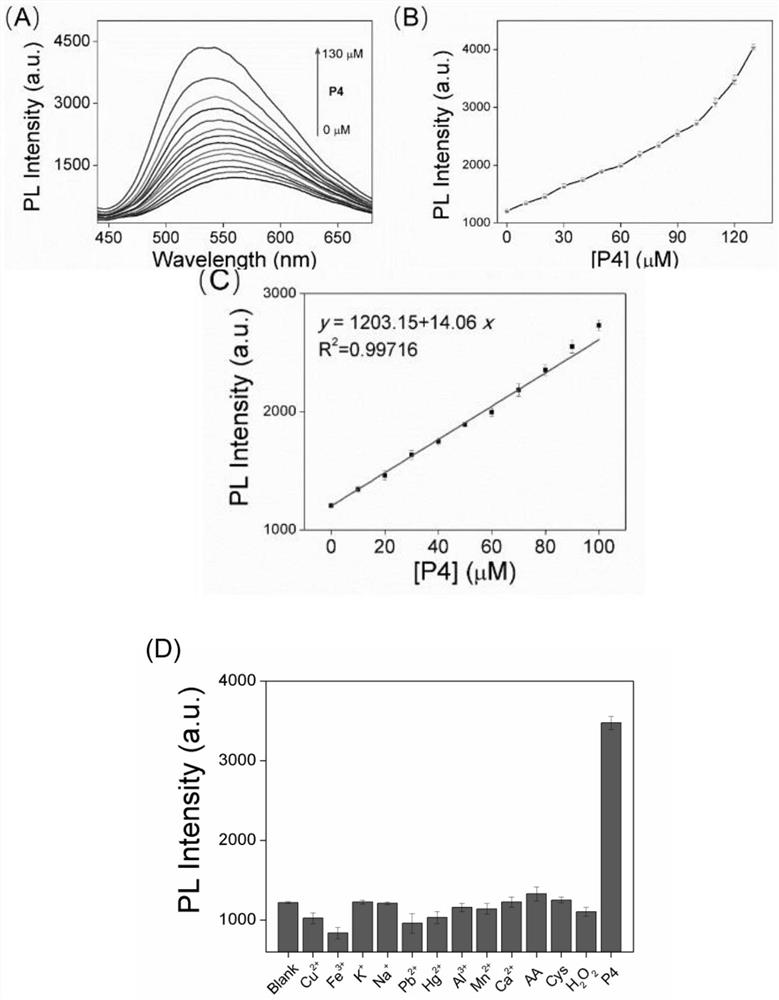Carbon dot for detecting progesterone and progesterone detection method
A detection method and progesterone technology, applied in the field of nanomaterials, can solve the problems of long sample pretreatment time, low sensitivity, long running time, etc., and achieve the effects of fast detection speed, broad application prospects and low detection limit.
- Summary
- Abstract
- Description
- Claims
- Application Information
AI Technical Summary
Problems solved by technology
Method used
Image
Examples
Embodiment 1
[0041] The present embodiment provides a carbon dot for detecting progesterone, which is prepared by the following steps:
[0042] 1) 0.5g curcumin was put into a beaker, heated at 180° C. for 6 hours in a reaction kettle, and a brown intermediate product was obtained;
[0043] 2) After the intermediate product was naturally cooled to room temperature, it was dissolved in ethanol and centrifuged at 5000 rpm for 30 minutes;
[0044] 3) The obtained centrifuge is dialyzed with a dialysis bag to remove unreacted small molecules, and the dialyzed product is then freeze-dried to obtain carbon dots.
[0045] refer to figure 1 , figure 1 A is the absorption spectrum of the carbon dots prepared in Example 1, figure 1 B is the emission spectrum of carbon dots under different wavelengths of excitation light, figure 1 In B, at the arrow position, the wavelengths increase sequentially from top to bottom, that is, the wavelengths of the curve here are 360, 380, 400, 420, 440, 460, and ...
Embodiment 2
[0047] This implementation provides a method for detecting progesterone, which uses the carbon dots prepared in Example 1 for detection, and the specific detection steps include:
[0048] 1) Construct a standard curve for progesterone detection:
[0049] Mix n parts of the progesterone solution with a certain concentration gradient each with a volume of v1 and a carbon dot solution with a volume of v2 and a concentration of c, and let stand;
[0050] The obtained n parts of the mixed solution are respectively at excitation wavelength of 410nm, and the fluorescence intensity value of the mixed solution is tested;
[0051] Taking the progesterone concentration as the abscissa and the fluorescence intensity as the ordinate, the standard curve for progesterone detection was obtained by fitting;
[0052] 2) Detect the progesterone concentration in the solution to be tested:
[0053] Mix the solution to be tested with volume v1 and the carbon dot solution with volume v2 and concen...
Embodiment 3
[0067] In this example, the interference experiment of carbon dots for the detection of progesterone concentration was performed.
[0068] In this embodiment, the interfering substances used include Cu 2+ , Fe 3+ ,K + ,Na + ,Pb 2+ ,Hg 2+ , Al 3+ ,Mn 2+ ,Ca 2+ ,AA,Cys,H 2 O 2 , the concentration is 120μmol / L. The experimental method is as follows: mix the carbon dots with 120 μmol / L interfering substance solution, and at the same time mix the same concentration of carbon dots with progesterone with a concentration of 120 μmol / L as a comparison, let stand for 3 minutes; then at the excitation wavelength of 350 nm, test Fluorescence intensity values of two mixed solutions; the above experiments were performed separately for all interferents. refer to figure 2 D, is the experimental result, in which P4 represents progesterone. It can be seen that only progesterone has an enhanced effect on the fluorescence of the Cdot solution, while other interfering substances hav...
PUM
 Login to View More
Login to View More Abstract
Description
Claims
Application Information
 Login to View More
Login to View More - R&D
- Intellectual Property
- Life Sciences
- Materials
- Tech Scout
- Unparalleled Data Quality
- Higher Quality Content
- 60% Fewer Hallucinations
Browse by: Latest US Patents, China's latest patents, Technical Efficacy Thesaurus, Application Domain, Technology Topic, Popular Technical Reports.
© 2025 PatSnap. All rights reserved.Legal|Privacy policy|Modern Slavery Act Transparency Statement|Sitemap|About US| Contact US: help@patsnap.com


